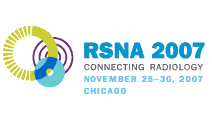
Abstract Archives of the RSNA, 2007
Gavin Hamilton PhD, Abstract Co-Author: Nothing to Disclose
Michael Simca Middleton PhD, MD, Presenter: Research Consultant, Siemens AG, Erlangen, Germany
Research Consultant, Confirma, Inc, Bellevue, WA
Grant, General Electric Company
Stockholder, General Electric Company
Grant, Bayer AG (Berlex Inc), Montville, NJ
Mark Bydder PhD, Abstract Co-Author: Research grant, General Electric Company, WI
Takeshi Yokoo, Abstract Co-Author: Nothing to Disclose
Jeffrey Schwimmer MD, Abstract Co-Author: Nothing to Disclose
Joel Lavine, Abstract Co-Author: Nothing to Disclose
Claude B. Sirlin MD, Abstract Co-Author: Research grant, Bayer AG, West Haven, CT
Research grant, General Electric Company, Fairfield, CT
et al, Abstract Co-Author: Nothing to Disclose
et al, Abstract Co-Author: Nothing to Disclose
¹H Magnetic Resonance Spectroscopy (MRS) offers the opportunity to quantify accurately intraheptocellular lipid (IHCL) levels. However, the accuracy of IHCL MRS measurement depends on the sequence used and whether T2s have been measured accurately to correct peak areas. We examine the effect that j-coupling present in lipid peaks has on the T2 given by the PRESS sequence in a phantom and patients, compared to the STEAM sequence.
MR spectra were obtained on a 1.5 Tesla Symphony scanner on an animal fat phantom and 33 patients (IRB approved). PRESS and STEAM sequences were obtained with TR 1500 ms, and voxel size 20 x 20 x 20 mm. For the PRESS sequence, spectra were taken at TE 30, 40, 50, 60 and 70 ms; STEAM spectra were taken at TE 20, 30, 40, 50, 60 and 70 ms. The spectra were quantified in the time domain using the AMARES algorithm included in the MRUI software program. We focused on the three main fat peaks at 2.2, 1.3, and 0.9 ppm.
In the animal fat phantom the PRESS sequence gave following T2 values for the three main lipid peaks: 2.1ppm 34.9ms, 1.3ppm 45.2ms and 0.9ppm 19.0ms. This compares to the T2 values given by the STEAM sequence: 2.1ppm 32.6ms, 1.3ppm 54.6ms and 0.9ppm 44.0ms. In the human subjects, the mean T2s given by PRESS were as follows: Water 38.8ms, 2.1ppm 17.4ms, 1.3ppm 59.0ms and 0.9ppm 19.2ms. For the STEAM sequence the human mean T2s were: Water 36.8ms, 2.1ppm 38.4ms, 1.3ppm 79.2ms and 0.9ppm 37.9ms. In both the phantom and the human subjects, the effect that the j-coupling of the lipid peaks has on the T2 estimate produced by the PRESS sequence is clear. It reduces the apparent T2s seen in PRESS sequence, resulting in the peak areas and being overestimated. This means that in patients, the PRESS sequence will over-estimate the fat deposition in the liver by about 40% compared to the STEAM sequence.
The results suggest that j-coupling will cause the PRESS sequence to underestimate T2 values and hence overestimate lipid levels given by T2 corrected peak areas.
Thus, our data shows that the choice of sequence will affect the estimated IHCL levels measured in vivo.
Hamilton, G,
Middleton, M,
Bydder, M,
Yokoo, T,
Schwimmer, J,
Lavine, J,
Sirlin, C,
et al, ,
et al, ,
Influence of MR Spectroscopy Sequence on the Measurement of IHCL Levels. Radiological Society of North America 2007 Scientific Assembly and Annual Meeting, November 25 - November 30, 2007 ,Chicago IL.
http://archive.rsna.org/2007/5011921.html

